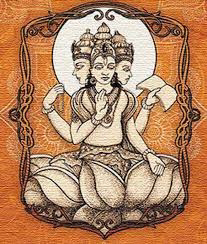III-1: Then Kausalya, son of Asvala, asked him, "O venerable sir, from where is this Prana born? How does He come into this body? How again does He dwell by dividing Himself? How does he depart? How does He support the external things and how the physical?"
अब कौसलदेश के आश्वलायन ने उनसे पूछा - भगवन् यह प्राण कहाँ से उत्पन्न होता है ? इस शरीर में कैसे आता है ? तथा स्वयं को विभक्त करके किस प्रकार स्थित होता है ? किस कारण उत्क्रमण करता है तथा किस प्रकार बाह्य और अन्तरजगत को धारण करता है ?॥१॥
तस्मै स होउवाचातिप्रष्चान् पृच्छसि ब्रह्मिष्ठोऽसीति तस्मात्तेऽहं ब्रवीमि ॥२॥
III-2: To him he said: You are putting super-normal questions, since you are pre-eminently a knower of Brahman. Hence I speak to you.
वे उससे बोले - ‘तू अतिप्रश्न पूछता है । तू ब्रह्म में श्रद्धा रखने वाला है अतः मैं तेरे सभी प्रश्नों का उत्तर दूँगा’ ॥२॥
आत्मन एष प्राणो जायते । यथैषा पुरुषे छायैतस्मिन्नेतदाततं मनोकृतेनायात्यस्मिञ्शरीरे ॥३॥
III-3: From the Self is born this Prana. Just as there can be shadow when a man is there, so this Prana is fixed on the self. He comes to this body owing to the actions of the mind.
यह प्राण आत्मा से उत्पन्न होता है । जिस प्रकार पुरुष से उसकी छाया उत्पन्न होती है उसी प्रकार प्राण आत्मा के ही आश्रित है । यह मन के द्वारा किये गए संकल्पों से इस शरीर में आता है ॥३॥
यथा सम्रादेवाधिकृतान् विनियुङ्क्ते । एतन् ग्रामानोतान् ग्रामानधितिष्टस्वेत्येवमेवैष प्राण इतरान् प्राणान् पृथक् पृथगेव सन्निधत्ते ॥४॥
III-4: As it is the king alone who employs the officers saying, "Rule over these villages, and those ones", just so Prana engages the other organs separately.
जिस भाँति सम्राट ही ‘इस ग्राम में तुम रहो, इस ग्राम में तुम रहो’ - इस प्रकार अधिकारियों को नियुक्त करता है, उसी प्रकार यह मुख्य प्राण ही दूसरे प्राणों को पृथक-पृथक नियुक्त करता है ॥४॥
पायूपस्थेऽपानं चक्षुःश्रोत्रे मुखनासिकाभ्यां प्राणः स्वयं प्रातिष्टते मध्ये तु समानः । एष ह्येतद्धुतमन्नं समं नयति तस्मादेताः सप्तार्चिषो भवन्ति ॥५॥
III-5: He places Apana in the two lower apertures. Prana Himself, issuing out of the mouth and nostrils, resides in the eyes and ears. In the middle, however, is Samana, for this one distributes equally all this food that is eaten. From that issue out these seven flames.
पायु और उपस्थ में ‘अपान’ को, मुख-नासिका-चक्षु-श्रोत्र में ‘प्राण’ स्वयं को और मध्य भाग में ‘समान’ को प्रतिष्ठित करता है । यह (समान) ही ग्रहण किये गए अन्न को समभाव से शरीर में वितरित करता है । उससे ही ये सात ज्वालाएँ उत्पन्न होती हैं ॥५॥
हृदि ह्येष आत्मा । अत्रैतदेकशतं नाडीनं तासां शतं शतमेकैकस्या द्वासप्ततिर्द्वासप्ततिः प्रतिशाखानाडीसहस्राणि भवन्त्यासु व्यानश्चरति ॥६॥
III-6: This self (i.e. the subtle body) is surely in the heart. There are a hundred and one of the (chief) nerves. Each of them has a hundred (division). Each branch is divided into seventy-two thousand sub-branches. Among them moves Vyana.
यह आत्मा हृदय में है । इस हृदयदेश में एक सौ एक नाड़ियाँ हैं । उनमें से एक-एक की सौ-सौ शाखाएँ हैं और बहत्तर-बहत्तर हजार प्रतिशाखा नाड़ियाँ होती है । इनमें ‘व्यान’ संचार करता है ॥६॥
अथैकयोर्ध्व उदानः पुण्येन पुण्यं लोकं नयति पापेन पापमुभाभ्यामेव मनुष्यलोकम् ॥७॥
III-7: Now then Udana, when it is in its upward trend, leads to a virtuous world as a result of virtue, to a sinful world as a result of sin and to the human world as a result of both.
इनमे एक ऊपर की ओर है, जिसमें गमन करने वाला ‘उदान’ पुण्य द्वारा पुण्यलोक में और पाप के द्वारा पाप लोक में ले जाता है और दोनों के उभय फलस्वरूप मनुष्यलोक में ॥७॥
आदित्यो ह वै बाह्यः प्राण उदयत्येष ह्येनं चाक्षुषं प्राणमनुगृह्णानः । पृथिव्यां या देवता सैषा पुरुषस्य अपानमवष्टभ्यान्तरा यदाकाशः स समानो वायुर्व्यानः ॥८॥
III-8: The sun is indeed the external Prana. It rises up favouring this Prana in the eye. That deity, that is in the earth, favours by attracting Apana in a human being. The space (i.e. air), that is within, is Samana. The (common) air is Vyana.
आदित्य ही वह बाह्य प्राण है जो चक्षु के प्राण पर अनुग्रह करता हुआ उदित होता है । पृथ्वी में जो देवता है वही पुरुष के अपान को आकर्षण किये हुए है । इन दोनों के बीच में यह जो आकाश है वह समान है और वायु ही व्यान है ॥८॥
तेजो ह वा उदानस्तस्मादुपशान्ततेजाः । पुनर्भवमिन्द्रियैर्मनसि सम्पध्यमानैः ॥९॥
III-9: That which if well known as luminosity, is Udana. Therefore, one who gets his light extinguished, attains rebirth together with the organs that enter into (his) mind.
तेज ही वह उदान है । इसलिए जिसका तेज शान्त हो जाता है, वह मन में लीन हुई इन्द्रियों सहित पुनर्जन्म को प्राप्त होता है ॥९॥
यच्चित्तस्तेनैष प्राणमायाति । प्राणस्तेजसा युक्तः सहात्मना तथासङ्कल्पितं लोकं नयति ॥१०॥
III-10: Together with whatever thought he had (at the time of death), he enters into Prana. Prana, in combination with Udana and in association with the soul, leads him to the world desired by him.
जैसा चित्त होता है, उस संकल्प के साथ ही मुख्य प्राण को प्राप्त हो जाता है । यह प्राण तेज से युक्त हो आत्मा सहित संकल्पानुसार भिन्न-भिन्न लोकों को ले जाता है ॥१०॥
य एवं विद्वान् प्राणं वेद न हास्य प्रजा हीयतेऽमृतो भवति तदेषः श्लोकः ॥११॥
III-11: The line of progeny of any man of knowledge who knows Prana thus sustains no break. He becomes immortal. Pertaining to this there occurs this mantra.
जो विद्वान् प्राण को इस प्रकार जानता है उसकी प्रजा नष्ट नहीं होती । वह अमर हो जाता है । ऐसा यह श्लोक है ॥११॥
उत्पत्तिमायतिं स्थानं विभुत्वं चैव पञ्चधा । अध्यात्मं चैव प्राणस्य विज्ञायामृतमश्नुते विज्ञायामृतमश्नुत इति ॥१२॥
III-12: Having known the origin, coming, lodgment and fivefold over lordship and the physical existence of Prana, one achieves immortality. Having known, one achieves immortality.
प्राण की उत्पत्ति, आगम, स्थान, विभुत्व और आध्यात्मिकता - इन पाँचों प्रकार से जानकर अमृत का अनुभव करता है, अमृत का अनुभव करता है ॥१२॥





No comments:
Post a Comment